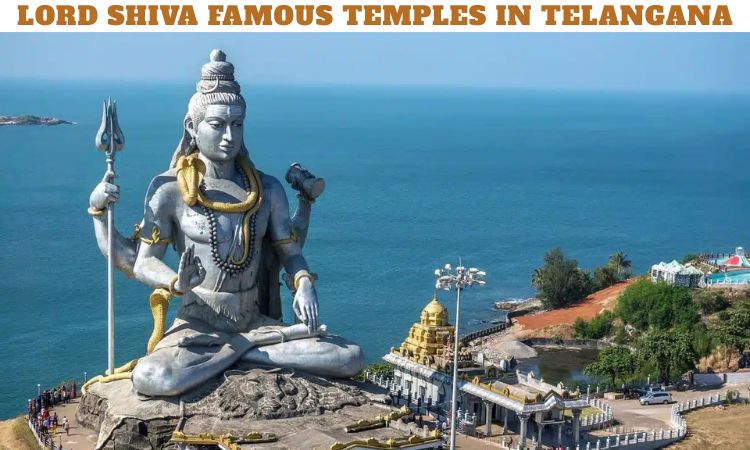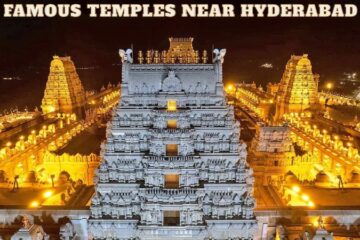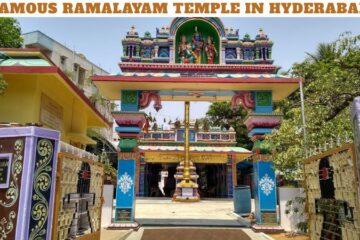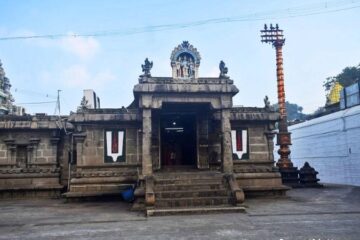
Table of Contents
Telangana, a land steeped in rich history, vibrant culture, and profound spirituality, is home to numerous ancient and revered temples dedicated to Lord Shiva. The state’s landscape is dotted with magnificent shrines that stand as testaments to centuries of devotion, architectural brilliance, and spiritual heritage. These temples dedicated to Lord Shiva in Telangana attract millions of devotees and tourists alike, offering a glimpse into the profound spiritual ethos of the region.
Lord Shiva, the Destroyer and Transformer in the Hindu Trinity, is worshipped in various forms across Telangana. From the tranquil banks of rivers to the serene hilltops, these temples encapsulate the essence of Shaivism, drawing pilgrims seeking blessings, peace, and spiritual solace. Many of these shrines boast a rich past, often linked to ancient dynasties like the Kakatiyas, Chalukyas, and Rashtrakutas, whose patronage led to the construction of architectural marvels.
1. Vemulawada Rajarajeshwara Swamy Temple, Rajanna Sircilla District
Often referred to as “Dakshina Kashi” (Kashi of the South), the Sri Rajarajeshwara Swamy Temple in Vemulawada is arguably the most famous Lord Shiva temple in Telangana. Dedicated to Lord Shiva as Rajarajeshwara Swamy, the temple complex is a significant pilgrimage site for devotees from across South India.
History and Legend: The temple’s origins are shrouded in antiquity, with legends tracing its roots back to the 8th century AD. It is believed to have been built by King Raja Narendra, a descendant of the Chalukya dynasty. The presiding deity, Lord Rajarajeshwara, is a Swayambhu Lingam (self-manifested idol). A unique aspect of this temple is the presence of a Dargah (a Sufi shrine) of Hazrat Syed Shah Qamaruddin Auliya within the temple premises, symbolizing communal harmony and religious tolerance.
Architecture and Significance: The temple showcases a blend of Chalukyan and Kakatiyan architectural styles. The main shrine houses the Shiva Lingam, and there are also sub-shrines dedicated to Goddess Parvati, Lord Ganesha, Lord Subramanya, and other deities. The temple complex includes a holy tank known as Dharma Gundam, where devotees take a dip before offering prayers. It is believed that a bath in this tank can cure ailments and purify the soul. The temple is particularly famous for its “Kode Mokku” ritual, where devotees offer a bull (Nandi) to the Lord, circumambulating the temple with the bull, seeking fulfillment of their vows.
Festivals: Maha Shivaratri is the most significant festival celebrated with immense fervor, attracting lakhs of devotees. Other festivals like Ugadi, Dasara, and Diwali are also observed with traditional rituals.
2. Kaleshwaram Mukteswara Swamy Temple, Jayashankar Bhupalpally District
Situated at the confluence of the Godavari and Pranahita rivers, the Kaleshwaram Mukteswara Swamy Temple holds immense spiritual significance. It is one of the three Shiva temples that form the “Trilinga Desam” (land of three Lingams), giving Telangana its ancient name.
History and Legend: The temple dates back to the Kakatiya period, with inscriptions indicating its renovation during the reign of Kakatiya King Prataparudra II. The unique feature of this temple is the presence of two Shiva Lingams on a single pedestal – one of Lord Shiva (Mukteswara) and the other of Yama Dharma Raja (Kaleshwara). It is believed that Yama, the God of Death, installed the Kaleshwara Lingam here, making it a sacred site for performing ancestral rites. The confluence of the two rivers, known as “Dakshina Triveni Sangamam,” further enhances its sanctity.
Architecture and Significance: The temple’s architecture reflects the Kakatiyan style, characterized by intricate carvings and sturdy structures. Devotees believe that worshipping both Lingams here grants liberation from the cycle of birth and death. The temple’s serene location by the riverbanks adds to its spiritual ambiance, making it a popular destination for pilgrims seeking peace and divine blessings.
Festivals: Maha Shivaratri, Karthika Pournami, and other auspicious days are celebrated with special pujas and rituals.
3. Ramappa Temple (Ramalingeswara Swamy Temple), Mulugu District
A UNESCO World Heritage Site, the Ramappa Temple, also known as the Ramalingeswara Swamy Temple, is an architectural marvel of the Kakatiya dynasty. While its official name is Ramalingeswara, it is popularly known as Ramappa after its chief sculptor, Ramappa, a rare tribute to an artisan.
History and Legend: Constructed in 1213 AD during the reign of Kakatiya ruler Ganapathi Deva, the temple is a masterpiece of Kakatiyan art and engineering. It is dedicated to Lord Shiva as Ramalingeswara. The temple’s unique feature is its “floating bricks” used in the construction of the gopuram, which are so light that they float on water.
Architecture and Significance: The temple stands on a star-shaped platform and is renowned for its intricate carvings, especially the bracket figures of dancing celestial nymphs (Madhanikas) that adorn the pillars. These sculptures are highly detailed, depicting various mythological scenes and aspects of daily life. The Nandi idol in front of the main shrine is another highlight, known for its alert posture, seemingly ready to spring to life. The temple’s sand-box foundation technique, which makes it earthquake-resistant, is a testament to the advanced engineering skills of the Kakatiya period. The temple’s serene setting amidst lush greenery further enhances its charm.
Festivals: Maha Shivaratri and other Shiva-related festivals are celebrated here with traditional grandeur.
4. Komuravelli Mallanna Swamy Temple, Siddipet District
The Komuravelli Mallanna Swamy Temple is a highly revered shrine dedicated to Lord Shiva in his manifestation as Mallanna, a folk deity popular in Telangana and parts of Karnataka and Maharashtra.
History and Legend: The temple is situated on a small hillock and is believed to be several centuries old. Lord Mallanna is considered a fierce yet benevolent deity, often associated with pastoral communities and their well-being. Legends speak of his divine powers and the fulfillment of devotees’ wishes.
Architecture and Significance: The temple complex is relatively simple but exudes a strong spiritual aura. The main deity is Lord Mallanna, accompanied by his consorts, Goddess Bhramaramba and Goddess Kethamma. The temple is particularly famous for its unique rituals and offerings, including “Bonam” (a traditional offering of cooked rice and jaggery) and animal sacrifices (though these are now mostly symbolic or replaced by other offerings). The temple draws a massive crowd, especially during the peak pilgrimage season, with devotees seeking blessings for prosperity, health, and progeny.
Festivals: The “Pedda Patnam” festival, celebrated during Sankranti, is the most important event, attracting lakhs of devotees. Other festivals like Ugadi and Dasara are also celebrated.
5. Keesaragutta Ramalingeswara Swamy Temple, Medchal-Malkajgiri District
Perched atop a picturesque hillock, the Keesaragutta Ramalingeswara Swamy Temple is an ancient and significant Lord Shiva shrine located near Hyderabad.
History and Legend: The temple’s history dates back to the Treta Yuga, with legends associating it with Lord Rama. It is believed that Lord Rama installed a Shiva Lingam here after returning from Lanka, to atone for the sin of killing Ravana, a Brahmin. Lord Hanuman was tasked with bringing a Lingam from Varanasi, but due to a delay, Lord Rama installed a self-manifested Lingam. When Hanuman arrived, he was disappointed, and in his anger, threw the Lingams he brought, which are now scattered across the hill, giving rise to the name “Keesaragutta” (hill of scattered Lingams).
Architecture and Significance: The temple complex offers panoramic views of the surrounding landscape. The main shrine houses the Swayambhu Lingam of Lord Ramalingeswara. The temple’s architecture, though renovated over centuries, retains elements of ancient Dravidian style. It is a popular destination for devotees performing “Abhishekam” and other rituals. The serene environment and historical significance make it a cherished pilgrimage spot.
Festivals: Maha Shivaratri is celebrated with great pomp and show, drawing thousands of devotees. Karthika Masam (the Hindu month of Karthika) is also a significant period for special prayers.
6. Erakeswara Swamy Temple, Pillalamarri, Suryapet District
The Erakeswara Swamy Temple at Pillalamarri is another hidden gem showcasing the architectural prowess of the Kakatiya period. While less known than Ramappa or Vemulawada, its historical and artistic value is immense.
History and Legend: This temple was constructed in 1208 AD by Erakasani, the wife of Recherla Rudra Reddy, a chieftain under Kakatiya King Ganapathi Deva. It is dedicated to Lord Shiva and is a fine example of Kakatiyan temple architecture. The village of Pillalamarri itself is historically significant, known for its ancient banyan tree (Pillalamarri means “children’s banyan tree”).
Architecture and Significance: The temple features a typical Kakatiyan layout with a garbhagriha (sanctum sanctorum), antarala (vestibule), and a mandapa (hall). The intricate carvings on the pillars, walls, and ceiling depict various mythological themes, deities, and floral patterns. The sculptures are characterized by their delicate detailing and vibrant expressions, reflecting the artistic zenith of the Kakatiya era. The temple’s tranquil setting provides a peaceful atmosphere for devotees and history enthusiasts.
Festivals: Local festivals and Shivaratri are celebrated here, attracting devotees from nearby villages.
The Spiritual Tapestry of Telangana’s Shiva Temples
The Lord Shiva famous temples in Telangana are more than just places of worship; they are living testaments to a rich spiritual and cultural legacy. Each temple tells a unique story, interwoven with myths, legends, and historical events. The architectural styles, predominantly Kakatiyan, showcase a remarkable blend of engineering precision and artistic finesse, characterized by intricate carvings, polished black basalt stone, and innovative construction techniques.
These temples serve as vital centers for the propagation of Shaivism, fostering devotion and preserving ancient traditions. The annual festivals, especially Maha Shivaratri, transform these serene shrines into bustling hubs of spiritual activity, where devotees participate in elaborate rituals, chanting, and devotional singing. The pilgrimage to these temples is not merely a religious act but a journey of self-discovery and connection with the divine.
Beyond their religious significance, these temples are also important heritage sites, attracting historians, archaeologists, and art enthusiasts. They offer invaluable insights into the social, cultural, and artistic practices of bygone eras. The efforts to preserve and promote these sites ensure that their legacy continues to inspire future generations.
In conclusion, the Lord Shiva’s famous temples in Telangana stand as enduring symbols of faith, art, and history. They invite pilgrims and visitors to experience the profound spiritual energy and witness the architectural grandeur that defines Telangana’s sacred landscape. A visit to these hallowed grounds is an enriching experience, leaving one with a sense of peace, devotion, and a deeper appreciation for the timeless spiritual heritage of India.
Frequently Asked Questions (FAQs)
1. Which is considered the most famous Lord Shiva temple in Telangana?
Ans. The Sri Rajarajeshwara Swamy Temple in Vemulawada, often called “Dakshina Kashi,” is arguably the most famous Lord Shiva temple in Telangana.
2. What is unique about the Vemulawada Rajarajeshwara Swamy Temple?
Ans. A unique aspect of this temple is the presence of a Dargah (a Sufi shrine) of Hazrat Syed Shah Qamaruddin Auliya within the temple premises, symbolizing communal harmony. It is also famous for the “Kode Mokku” ritual.
3. Why is Kaleshwaram Mukteswara Swamy Temple significant?
Ans. The Kaleshwaram Mukteswara Swamy Temple is significant because it features two Shiva Lingams on a single pedestal (Mukteswara and Kaleshwara) and is located at the confluence of the Godavari and Pranahita rivers, known as “Dakshina Triveni Sangamam.” It is also one of the “Trilinga Desam” temples.
4. What is the Ramappa Temple known for, besides being a Shiva temple?
Ans. The Ramappa Temple, a UNESCO World Heritage Site, is renowned for its architectural brilliance, including “floating bricks” used in its gopuram and intricate carvings, particularly the bracket figures of dancing celestial nymphs (Madhanikas). It’s also named after its chief sculptor, Ramappa.
5. Which dynasty primarily patronized the construction of these Shiva temples in Telangana?
Ans. Many of these shrines boast a rich past, often linked to ancient dynasties like the Kakatiyas, Chalukyas, and Rashtrakutas, with the Kakatiyas being particularly prominent in the construction of temples like Ramappa and Kaleshwaram.
6. What is the “Kode Mokku” ritual at Vemulawada?
Ans. The “Kode Mokku” ritual at Vemulawada involves devotees offering a bull (Nandi) to Lord Rajarajeshwara and circumambulating the temple with the bull, seeking fulfillment of their vows.
7. What is the legend behind the Keesaragutta Ramalingeswara Swamy Temple?
Ans. Legend has it that Lord Rama installed a Shiva Lingam here after returning from Lanka. Lord Hanuman, tasked with bringing Lingams from Varanasi, was disappointed by the delay and scattered his Lingams across the hill, giving it the name “Keesaragutta” (hill of scattered Lingams).
8. What kind of deity is Lord Mallanna at Komuravelli?
Ans. Lord Mallanna at Komuravelli is a manifestation of Lord Shiva, considered a fierce yet benevolent folk deity popular in Telangana and parts of Karnataka and Maharashtra, often associated with pastoral communities.
9. What are some common festivals celebrated at these Shiva temples?
Ans. Maha Shivaratri is the most significant festival celebrated with immense fervor at almost all these temples. Other festivals like Ugadi, Dasara, Diwali, Karthika Pournami, and “Pedda Patnam” (at Komuravelli) are also observed.
10. What architectural style is predominantly seen in these temples?
Ans. The architectural styles of these temples predominantly showcase the Kakatiyan style, characterized by intricate carvings, sturdy structures, and innovative construction techniques like the sand-box foundation.


